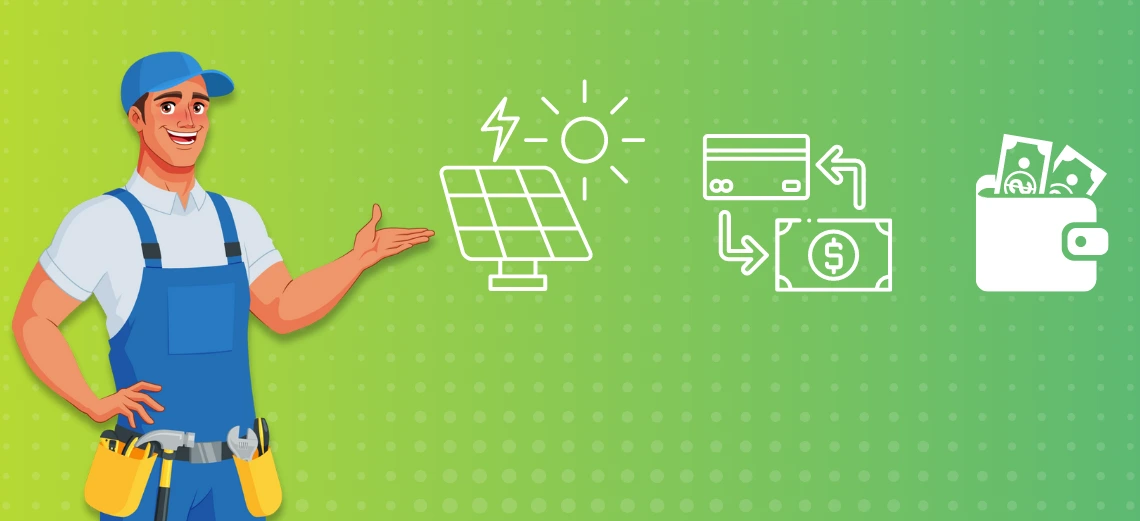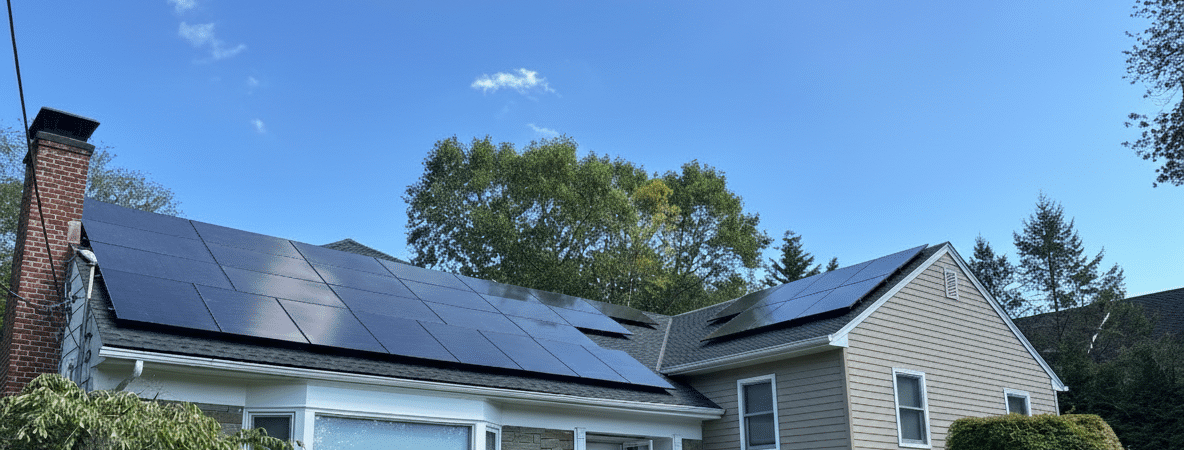In today’s world, environmental awareness has become a significant topic, and renewable energy sources are not just a trend but a necessity. As homeowners, industries, and governments worldwide make the shift towards greener energy solutions, understanding the intricacies behind these options becomes crucial.
One such concept that has caught everyone’s attention, especially in the field of solar energy, is the Solar Renewable Energy Certificate, commonly known as an SREC. But what exactly are SRECs? Well, SRECs represent the environmental benefits of producing one megawatt-hour of electricity.
Based on the report from Energy Sage, a solar panel system with a potential of 10 kW generates approximately 10 to 13 MWh of electricity each year. Consequently, this would yield an annual earning of 10 to 13 SRECs and help you take financial benefits from the credits.
In this blog, we will discuss how do SRECs work and why they are important in the journey toward a sustainable future. Let’s Discuss!
Understanding Solar Renewable Energy Credits (SRECs)
A Solar Renewable Energy Credit, commonly known as an SREC, is a tradable certificate that symbolizes the production of solar energy. Specifically, each SREC is earned when a solar power system generates 1,000 kilowatt-hours (kWh) of electricity.
Key Features of SRECs
- Transferable Commodity: SRECs can be bought and sold separately from actual electricity, making them a valuable asset for homeowners and businesses with solar systems.
- Environmental Impact: By generating and trading SRECs, you support cleaner energy production and help reduce carbon footprints.
- Incentive for Solar Adoption: In various regions, SRECs provide financial incentives to install solar panels, encouraging more widespread use of renewable energy sources.
How They Work
When solar panels on your property produce energy, the system records each megawatt-hour (1,000 kWh) generated, and you earn SRECs for this production. Utilities or companies seeking to meet renewable energy standards often purchase these credits to comply with regulations. This creates a market where SRECs can be traded, allowing solar producers to benefit financially.
By participating in the SREC market, whether by generating or trading, you play a crucial role in advancing the adoption of solar energy.
SRECs, or Solar Renewable Energy Certificates, are tradable environmental commodities that generate a certain amount of electricity from a solar energy source. An SREC shows how good it is for the environment to make one megawatt-hour (MWh) of power from solar energy sources.
If you produce 1,000 kWh (1 MWh) of solar power from solar panels, you get one SREC, which is a useful credit. SRECs are very valuable because utility companies are required by the state’s Renewable Portfolio Standard (RPS) to buy a certain number of them every year. These credits are very important for encouraging the use of solar energy and meeting green energy goals.
1 SREC = 1 MWh of solar power production = 1,000 kWh of solar power production
Why Do SRECs Exist?
Governments and organizations are keen on reducing greenhouse gas emissions & encouraging the usage of renewable energy. Many states or regions have implemented Renewable Portfolio Standards or similar mandates to achieve this.
These standards require utility companies to produce a certain percentage of energy from renewable sources. If they can’t generate enough themselves, they can buy SRECs to meet these requirements. This creates a market for SRECs.
How is the Value of an SREC Determined?
The value of an SREC is based on how much demand and supply there is in the solar market. According to Solar.com, the value of an SREC varies from $3.50 to nearly $400, depending on the solar market. Among the things that affect its price are:
- If a state has strict RPS requirements, there may be more desire for SRECs, which could cause prices to go up.
- Alternative Compliance Payments are a fee that utilities have to pay if they don’t meet their RPS standards. If the ACP is high, utilities may be more likely to buy SRECs instead of paying the fee, which drives up the price of SRECs.
- If there are a lot of solar systems in a state, there could be too many SRECs, which could cause their price to go down.
There are several other ways for a solar company and sellers who have to follow the RPS to meet the standard. They can make or buy the green energy they need on their own, or they can purchase renewable energy credits (REC) from people who own renewable energy. This includes people who live in homes with solar panels on the roof.
So, when utility companies buy RECs instead of building their own solar farms, your SRECs are worth the money. Moreover, understanding “how does SREC work” is key to unlocking the financial incentives behind solar energy production.
Pro Tip: [To know more about solar panel installation for your Commercial property, click here!]
How Much Is an SREC Worth in New Jersey?
The value of Solar Renewable Energy Certificates (SRECs) in New Jersey can vary throughout the day due to market demand and supply dynamics.
Here’s a breakdown of current SREC values by vintage year:
- 2025 Vintage SRECs: Approximately $195.00.
- 2024 Vintage SRECs: Approximately $207.00.
For the most accurate and up-to-date pricing, it’s advisable to check live market rates or consult with platforms that publish real-time SREC data. Keep in mind that these values can fluctuate as the market conditions change.
How Does the Generation Attribute Tracking System (GATS) Know What
My Solar Array Has Generated?
To accurately track and verify the energy your solar array produces, GATS relies on detailed reporting. Here’s how the system works:
- Reporting Your Solar Data: You’ll need to report your solar array’s energy generation to GATS. This is an essential step for creating Solar Renewable Energy Certificates (SRECs).
- For Full-Service Clients: If you’re using a management service that handles SREC sales, they often take care of this reporting for you. These services automatically submit your generation data to GATS, sparing you the hassle.
- For Self-Managed Clients: If you’re managing your SREC transactions independently, you must first create an account with GATS. Then, register your solar facility on the platform to ensure your energy production is correctly attributed to you.
By keeping your account updated and submitting accurate generation data, GATS can effectively track the energy your solar array generates. This process is crucial for verifying SRECs and ensuring you receive the appropriate credits.
How Can You Sell Your SRECs?
Step #1 Register Your System
Before your system generates SRECs, it typically needs to be certified and registered with the appropriate state rules and regulations.
Step #2 How You Want to Sell Your SRECs?
After registration, you can begin selling your SRECs. Here are your three alternative ways to sell your SREC:
- Receive an immediate payment by selling the rights to all SRECs from your energy system.
- Enter into a contract to sell your SRECs over a specified duration, typically three, five, or ten years.
- Opt for spot market sales, selling your SRECs as they’re generated.
Step #3 Agreement on Contracts for SREC
- Sign an official contract with a known SREC collector for a set amount of time, which is usually three, five, or ten years. This deal ensures that your Solar Renewable Energy Credits (SRECs) will always be worth the same amount.
- When your system creates an SREC, the aggregator has to send you cash.
- The aggregator sells your SRECs on your account and keeps a small portion of the money as payment.
Advantages
- Gives you a guaranteed SREC rate for the length of the deal, protecting you from any changes in the market.
- Gives more information about how much money is expected to come in from SRECs, which helps with more accurate financial planning.
- Your financial interests are protected in case the price of SRECs drops quickly.
Disadvantages
- SRECs contracts don’t start making you money until your system starts making energy, so they don’t help you save on installation costs immediately.
- When contracts are for a longer duration of time, each SREC may bring in less money.
- If the price of SRECs goes up for no reason, you could lose money if you agree to a set rate.
Who Purchases SRECs?
SRECs, or Solar Renewable Energy Certificates, are primarily bought by electricity providers. These companies, especially those operating in New Jersey, are legally required to purchase a certain amount of SRECs to meet state-imposed renewable energy standards.
Electricity suppliers must continuously acquire new SRECs as they become available, often paying more for newer certificates compared to older ones. This is to ensure compliance with state regulations, which grow stricter each year. If companies fail to purchase the necessary SRECs, they face an Alternative Compliance Payment, serving as a penalty for not meeting the mandated SREC quota.
By purchasing SRECs, power companies help drive the market for renewable energy, supporting the transition to sustainable power sources.
Who Creates SRECs?
SRECs, or Solar Renewable Energy Certificates, are produced through a specific tracking system known as the Generation Attribute Tracking System (GATS). This system meticulously monitors the renewable energy that flows through the PJM power grid.
Here’s a simple breakdown:
- Tracking Energy Production: GATS keeps a close watch on renewable energy sources and aggregates the data.
- Certification Process: Once the energy production is tracked, GATS generates SRECs by verifying and certifying the renewable energy supplied.
- Monthly Minting: SRECs are issued once a month—specifically on the last business day. The minting is a month behind, meaning energy generated in February is certified in March.
- Energy Threshold: For every 1,000 kWh (or 1 MWh) of renewable energy produced, one SREC is created. If production doesn’t reach this number, the remainder carries over to the next month.
This structured process ensures that every SREC represents a verified amount of renewable energy, helping promote renewable energy use within the power grid.
Conclusion
In conclusion, SRECs offer an excellent opportunity for solar energy adopters to capitalize on their commitment to sustainable energy. By understanding “how do SRECs work” and aligning with knowledgeable industry professionals, one can maximize their solar installations’ financial and environmental benefits.
Engaging with trusted professionals is important for those considering adopting solar energy services for their homes. Companies like Infinity Energy offer expertise in solar panel installations, ensuring that homeowners and businesses can seamlessly transition to renewable energy and benefit from SRECs. Get a free estimate today!












